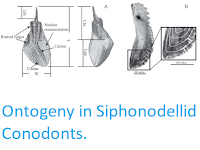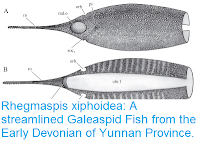Conodonts are curious microfossils found in rocks from the Cambrian to
the Triassic in many parts of the world. They are tooth-like structures,
comprising a number of distinct elements made from the same material as
the teeth of Vertebrates, but distinct from the teeth of any known
Vertebrate, with each Conodont apparently having a unique set of these
structures. For many years the animals that produced these fossils were a
mystery, but they are now known to have been Eel-like organisms,
considered to be Chordates closely related to, but outside the
Vertebrate group. However, this reconstruction is based upon the largest Conodont group, the Euconodonts, with two other groups having been tentatively assigned to the greater Conodonta, the Protoconodonts, which are now considered to be related to the Chaetognaths (Arrow Worms), and the Paraconodonts, a group which known only from simple elements made from the same material as Conodont elements and Vertebrate teeth. The Paraconodonts are known from the Early Cambrian to the Early Devonian, and though know soft tissue is known from this group, they are considered to very closely related to the Euconodonts, or even the group from which the Euconodonts sprang.
In a paper published in the Journal of Paleontology on 31 October 2018, John Peel of the Department of Earth Sciences at Uppsala University, describes a new species of Paraconodont from the Early Cambrian Henson Gletscher Formation of southern Freuchen Land and Peary Land, in northern Greenland, deposits
that form part of the Small Shelly Fauna at the beginning of the
Cambrian (the Small Shelly Fauna marks the beginning of the Cambrian
in deposits around the world; in these beds numerous small shells and
shell-elements are found, but not larger mineralised shells).
The new species is placed in the genus Tarimspira, which has previously been described from Xinjiang and Zhejiang provinces in China, and given the specific name artemi, in honour of Artem Kouchinsky of the Swedish Museum of Natural History, for his work on Early Cambrian faunas. The species is described from a series of specimens, which have an open, coiled shape, lacking a spiral keel around the periphery.
Tarimspira artemi, Henson Gletscher Formation, Cambrian Series 2, Stage 4; GGU sample 301354, southern Freuchen Land, North Greenland, unless stated. Morphotype B2 unless stated. (1) PMU 31853; (2), (3) PMU 31854; (4), (6), (7) PMU 31855, with arrow in (7) indicating the last deposited growth lamella extending from the base onto the lateral areas; (5) PMU 31856; (8) PMU 31858 from GGU sample 271748 Løndal, Peary Land, morphotype B; (9) PMU 31857; (10) PMU 31859 from GGU sample 218584, Henson Gletscher Formation, Henson Gletscher, southwest Peary Land, morphotype E. Scale bars are 50 μm. Peel (2018).
See also...
Follow Sciency Thoughts on
Facebook.





